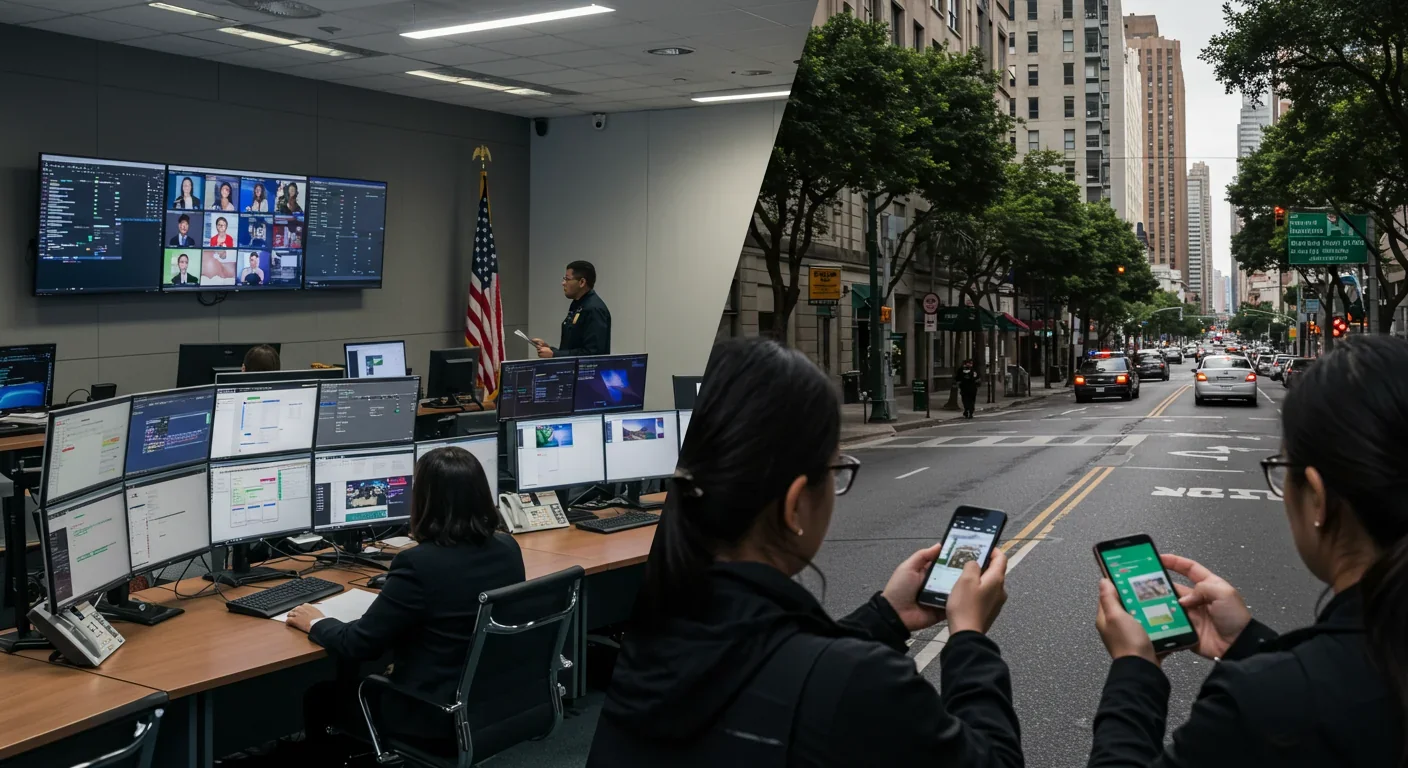Who Decides What We Can Say Online? The Hidden Truth

TL;DR: Cities worldwide are transforming governance through digital platforms, from Seoul's participatory budgeting to Barcelona's open-source legislation tools. While these innovations boost transparency and engagement, they also create new challenges around digital divides, misinformation, and privacy.

By 2030, the average city resident will have more direct influence over local policy than at any point in modern democratic history. Not because we're voting more often, but because the line between government and governed is disappearing. Seoul residents already use their phones to decide how 5 million dollars gets spent each year. Barcelona citizens debate and shape city ordinances from their living rooms. Emergency managers in US cities track floods through Twitter feeds faster than official sensors can report them. What started as governments awkwardly tweeting weather updates has morphed into something that would've seemed like science fiction a decade ago: genuine two-way governance happening at the speed of a notification.
Cities didn't wake up one morning and decide to become digital. They got dragged kicking and screaming by citizens who'd grown used to Amazon responding in minutes but had to wait weeks for a pothole repair. The transformation began quietly around 2008, when a few innovative mayors realized social media wasn't just for brands and teenagers.
New York City's 311 system became the poster child for this shift. What started as a phone hotline evolved into a digital platform processing over 3 million service requests annually, with residents reporting everything from noise complaints to broken streetlights through an app. The data revealed patterns city planners had missed for decades, showing which neighborhoods needed more resources and when problems peaked.
But emergency management agencies proved to be the real pioneers. When disasters struck, they discovered social media wasn't just a broadcast channel; it was a sensor network powered by millions of eyewitnesses. During floods, earthquakes, and hurricanes, local emergency teams started monitoring Twitter and Facebook not because it was trendy, but because it was faster and more detailed than traditional reporting systems. Citizens became unwitting first responders, documenting conditions in real-time while official channels lagged behind.
The shift accelerated during the 2010s as smartphones became ubiquitous. Cities realized they weren't just managing infrastructure anymore; they were managing information flows. The question changed from "How do we inform citizens?" to "How do we have conversations with them?" That's when things got interesting.
Seoul took the concept further than almost anyone else. The South Korean capital launched the Seoul Smart City initiative, which treats the entire city as a living laboratory for digital governance. Through the mVoting platform, residents vote on actual policy decisions, not just symbolic surveys. The city's participatory budgeting program lets citizens propose projects and decide how to spend millions in public funds.
What makes Seoul's approach revolutionary isn't the technology itself—it's the trust embedded in the system. When city officials implemented over 7,000 citizen proposals between 2012 and 2019, they proved that digital platforms could do more than collect feedback; they could transfer actual decision-making power. Residents proposed LED streetlight installations in unsafe areas, expansion of bicycle lanes, and improvements to public spaces. The city didn't just listen; it implemented.
The platform succeeded because it closed the loop. Citizens didn't just submit ideas into a black hole; they saw real results, tracked implementation progress, and held officials accountable through transparent dashboards. That feedback mechanism transformed skeptics into participants.
While Seoul focused on top-down digital infrastructure, Barcelona went a different route: radical openness. The city launched Decidim, an open-source platform where residents don't just vote on proposals—they write legislation.
During Barcelona's tenure as Europe's first Capital of Democracy, over 40,000 citizens used Decidim to participate in crafting the city's strategic plan. They debated, amended, and finalized actual municipal policy. It wasn't symbolic participation; it was direct democracy at scale. The platform allowed people to propose initiatives, gather support, debate amendments, and vote on final versions. If a proposal got enough backing, the city council had to formally consider it.
The brilliance of Decidim lies in its transparency. Every discussion, every amendment, every vote remains publicly visible. Citizens can see exactly how their input shaped final decisions, which proposals succeeded, and why others failed. That transparency builds trust in ways traditional government communication never could.
Barcelona didn't stop at their own city limits. They open-sourced the entire platform, allowing other municipalities worldwide to deploy their own versions. Helsinki, Mexico City, and dozens of smaller cities now run on Decidim variants. It's government-as-a-service, but without the corporate middleman.

American cities took a more pragmatic path, focusing less on revolutionary democracy and more on solving immediate problems. The results have been quietly transformative.
CivicPlus research shows that municipalities using mobile apps see significant improvements in resident satisfaction. Citizens can report issues, pay bills, check permit status, and access public records without visiting city hall. For smaller cities with limited staff, these platforms effectively clone their workforce—automation handles routine requests while employees focus on complex problems.
Government social media campaigns have evolved far beyond simple announcements. A 2025 study found that cities posting basic local news on Facebook actually engage more citizens than those using flashy multimedia campaigns. Residents don't want entertainment from their city government; they want useful information delivered consistently. The most successful campaigns treat social channels like neighborhood bulletin boards, not marketing platforms.
Digital.gov, the US government's digital services resource, documents how federal and local agencies transformed social media from an afterthought into a core communication strategy. Agencies learned to segment audiences, tailor messages by platform, and measure engagement beyond vanity metrics. The focus shifted from broadcast to conversation, from talking at citizens to talking with them.
The platforms themselves matter less than what they enable. Modern civic engagement tools do three things that traditional government never could: they meet citizens where they are, they operate 24/7, and they remove geographic barriers.
Civic technology platforms now cover everything from participatory budgeting to real-time service tracking. SeeClickFix lets residents report problems and watch their neighbors upvote issues, creating organic prioritization. Nextdoor connects neighborhood-level concerns with local officials. Change.org and similar petition platforms force government responses to citizen-initiated campaigns.
The real innovation isn't the apps—it's the expectation shift. Citizens who've grown up with instant customer service from private companies now demand the same responsiveness from public institutions. Cities that don't adapt face a legitimacy crisis. Why should I trust a government that takes three weeks to respond to an email when my bank answers chat messages in minutes?
Artificial intelligence is beginning to reshape this landscape further. Google's Jigsaw project explores using AI to facilitate civic dialogue, though the results remain mixed. AI can help moderate discussions, translate languages in real-time, and flag urgent issues automatically. But it can also amplify biases, misinterpret context, and reduce nuanced policy debates to binary choices.
Digital platforms did something unexpected: they made government boring in the best possible way. When municipalities implement transparency tools, citizens stop speculating about waste and corruption because they can see exactly where money goes.
Performance dashboards show real-time metrics: how long it takes to fill potholes, what percentage of permits get approved, how police respond to calls. Budget visualization tools let anyone drill down from total spending to individual line items. Open data portals give journalists, researchers, and citizens raw information to analyze themselves.
This radical transparency changes political dynamics. It's harder to promise impossible things when everyone can see historical performance. It's harder to hide failures when every service request has a public ticket number. Politicians hate it. But it forces government to deliver results rather than just messaging.
The most successful transparency initiatives don't just dump data online; they contextualize it. A number like "$2.3 million spent on road repairs" means nothing without comparison. But showing that number alongside last year's spending, neighboring cities' spending, and the number of lane-miles repaired gives citizens actual insight. The difference between information and understanding is context.
The evidence for digital civic engagement's effectiveness keeps piling up. Research on government social media campaigns documents seven municipalities that dramatically improved service delivery through strategic social media use.
Louisville, Kentucky, used Facebook to promote COVID-19 vaccination clinics, reaching demographics that traditional public health messaging missed. The city's posts generated thousands of shares and comments, creating organic community health education that official PSAs never achieved.
Miami Beach leveraged Instagram to address traffic and parking issues during peak tourism season. By posting real-time updates about lot availability and traffic conditions, they reduced congestion complaints by 30 percent while improving the visitor experience.
Smaller cities saw even more dramatic impacts. When municipalities with populations under 50,000 launch comprehensive digital engagement strategies, they effectively multiply their government's capacity. A city with three people in the communications department can reach more residents through strategic social media use than they could with a staff of thirty using traditional methods.
Not everything about this transformation deserves celebration. The same platforms that enable engagement also enable manipulation, misinformation, and exclusion.
The biggest challenge facing emergency management agencies using social media isn't technology—it's public fragmentation. People scatter across dozens of platforms: Facebook, Twitter, Instagram, TikTok, Nextdoor, Telegram, and countless others. Posting crucial safety information everywhere demands resources most cities lack. Even worse, each platform has different demographics, so messages reach some communities while missing others entirely.
Information integrity poses an even harder problem. During emergencies, social media fills with rumors, panic, and outright lies. Officials must simultaneously broadcast accurate information and combat misinformation, often while their own staff struggles to verify ground truth. The speed that makes social media valuable for disaster response also makes it dangerous.
The digital divide remains stubbornly persistent. Older residents, low-income families, and rural communities often lack reliable internet access or digital literacy. When cities move services online, they risk abandoning the most vulnerable populations. A civic engagement platform that only hears from tech-savvy professionals isn't democratic; it's a new form of gatekeeping.
Privacy concerns multiply as cities collect more citizen data. Service request apps track locations. Participation platforms log opinions and voting patterns. Analytics tools profile engagement. The same transparency that builds trust in government could enable surveillance. Cities insist they anonymize and protect data, but breaches happen, policies change, and today's harmless information could become tomorrow's weapon.

While Seoul and Barcelona pioneer digital democracy, most of the world's cities struggle with basic infrastructure. The gap between digital leaders and laggards isn't just technological; it's economic, political, and cultural.
Developing nations face compounding challenges: limited internet penetration, lower smartphone ownership, weaker digital literacy, and governments less inclined toward transparency. When activists in authoritarian countries try to use digital platforms for civic engagement, they risk surveillance and retaliation. The same tools that empower citizens in democracies can oppress them in dictatorships.
Even within wealthy nations, disparities persist. Small rural towns can't afford the staff, technology, or expertise that large cities deploy. County governments lag behind municipalities. School boards and special districts barely maintain websites, let alone sophisticated engagement platforms.
The platforms themselves reflect Silicon Valley's biases and assumptions. They optimize for engagement, which sometimes means amplifying outrage over deliberation. They assume constant connectivity, which excludes intermittent users. They privilege written communication, which disadvantages people who communicate better verbally or visually. True digital civic engagement needs to work for everyone, not just for young urban professionals who live online.
The transition to digital civic engagement demands new skills from citizens. Democracy has always required informed, active participation, but the digital version adds technical and critical thinking demands.
Media literacy tops the list. Citizens must learn to distinguish reliable information from misinformation, recognize manipulation tactics, and verify sources. Schools need to teach these skills from elementary grades forward, treating them as fundamental as reading and math.
Digital security matters more than most people realize. When citizens interact with government platforms, they share personal information and express political opinions. Understanding basic privacy practices—strong passwords, two-factor authentication, careful app permissions—protects individuals and strengthens democratic systems.
Constructive online dialogue requires practice. The same platforms that enable participation also encourage performative outrage and tribal signaling. Citizens need to learn how to disagree productively, assume good faith, and build coalitions across differences. Digital civic engagement only works if the conversation remains civil enough to be useful.
The truth about local government and social media is that it requires effort from both sides. Cities must maintain active, responsive channels. Citizens must engage substantively rather than just complaining. It's a partnership, not a customer service relationship.
The next phase of digital civic engagement will be shaped by several emerging technologies and trends, each carrying both promise and risk.
Artificial intelligence will increasingly mediate between citizens and government. Chatbots will handle routine inquiries, freeing staff for complex issues. Natural language processing will analyze thousands of comments to identify common themes and concerns. Machine learning will predict service needs before citizens report them. But AI also threatens to depersonalize government interaction and entrench algorithmic biases.
5G networks and ubiquitous connectivity will enable real-time civic participation from anywhere. Imagine voting on local issues during your commute, or reporting problems as you encounter them without pulling out your phone. Frictionless engagement could dramatically increase participation. Or it could reduce civic engagement to mindless button-clicking, democracy as dopamine.
Blockchain technology promises tamper-proof voting and transparent record-keeping. Estonia already uses blockchain to secure government records and enable digital citizenship. But blockchain's complexity creates new barriers to access and understanding. Most citizens can conceptually understand paper ballots; few understand distributed ledgers.
Augmented reality might transform how people interact with their physical environment and local government. Point your phone at a building to see permit history, zoning information, and proposed changes. Overlay crime statistics, service requests, and budget impacts on a map of your neighborhood. AR could make government information contextual and immediate. Or it could overwhelm people with data they can't process.
The platforms themselves will evolve. Today's social media giants might fragment or consolidate. New networks will emerge, each fragmenting the public square further. Governments will struggle to maintain presence everywhere, forcing choices about which platforms to prioritize and which communities to potentially neglect.
The most successful digital civic engagement strategies share common elements, regardless of technology or population size.
They start with strategy, not platforms. Cities must define goals—increase voter participation, improve service delivery, build community trust—before choosing tools. Technology enables strategy; it doesn't replace it.
They prioritize accessibility and inclusion. Every digital tool should have offline alternatives. Content must work for people using screen readers, old devices, or slow connections. Outreach should target underserved communities, not just early adopters.
They close the feedback loop. Citizens need to see their input lead to actual results, or they'll stop participating. Even when a proposal gets rejected, explanation matters. Transparency about decision-making builds trust that outlasts any single issue.
They invest in people, not just technology. The best civic engagement platform without staff to maintain it, respond to citizens, and act on input becomes a ghost town. Cities need to hire community managers, social media specialists, and engagement coordinators.
They measure what matters. Vanity metrics like follower counts and page views don't indicate success. Better measures include response time to citizen inquiries, implementation rate of citizen proposals, diversity of participants, and resident satisfaction with government responsiveness.
The transformation of municipal governance through digital platforms isn't coming; it's here. The question isn't whether your city will adopt these tools, but how quickly and how effectively.
For city officials, this means accepting that citizens now expect the responsiveness they get from private companies. Slow, opaque government isn't just frustrating; it's becoming obsolete. The good news: the tools exist, the case studies provide roadmaps, and early adopters can leapfrog to the front.
For residents, this means recognizing that civic engagement no longer requires attending boring meetings or waiting in line at city hall. You can influence local policy from your couch, report problems during your morning walk, and hold officials accountable through transparent data. But that power requires active use. Digital democracy only works if people show up digitally.
The cities that thrive in coming decades won't necessarily be the biggest or wealthiest. They'll be the ones that figured out how to harness collective intelligence, respond to citizen needs in real-time, and build trust through radical transparency. The technology exists. The blueprints are proven. What's missing is the will to implement them everywhere.
Your city could be next. The question is: what are you waiting for?

The Bussard Ramjet, proposed in 1960, would scoop interstellar hydrogen with a massive magnetic field to fuel fusion engines. Recent studies reveal fatal flaws: magnetic drag may exceed thrust, and proton fusion loses a billion times more energy than it generates.

Mitophagy—your cells' cleanup mechanism for damaged mitochondria—holds the key to preventing Parkinson's, Alzheimer's, heart disease, and diabetes. Scientists have discovered you can boost this process through exercise, fasting, and specific compounds like spermidine and urolithin A.

Shifting baseline syndrome explains why each generation accepts environmental degradation as normal—what grandparents mourned, you take for granted. From Atlantic cod populations that crashed by 95% to Arctic ice shrinking by half since 1979, humans normalize loss because we anchor expectations to our childhood experiences. This amnesia weakens conservation policy and sets inadequate recovery targets. But tools exist to reset baselines: historical data, long-term monitoring, indigenous knowle...

Social media has created an 'authenticity paradox' where 5.07 billion users perform carefully curated spontaneity. Algorithms reward strategic vulnerability while psychological pressure to appear authentic causes creator burnout and mental health impacts across all users.

Scientists have decoded how geckos defy gravity using billions of nanoscale hairs that harness van der Waals forces—the same weak molecular attraction that now powers climbing robots on the ISS, medical adhesives for premature infants, and ice-gripping shoe soles. Twenty-five years after proving the mechanism, gecko-inspired technologies are quietly revolutionizing industries from space exploration to cancer therapy, though challenges in durability and scalability remain. The gecko's hierarch...

Cities worldwide are transforming governance through digital platforms, from Seoul's participatory budgeting to Barcelona's open-source legislation tools. While these innovations boost transparency and engagement, they also create new challenges around digital divides, misinformation, and privacy.

Every major AI model was trained on copyrighted text scraped without permission, triggering billion-dollar lawsuits and forcing a reckoning between innovation and creator rights. The future depends on finding balance between transformative AI development and fair compensation for the people whose work fuels it.